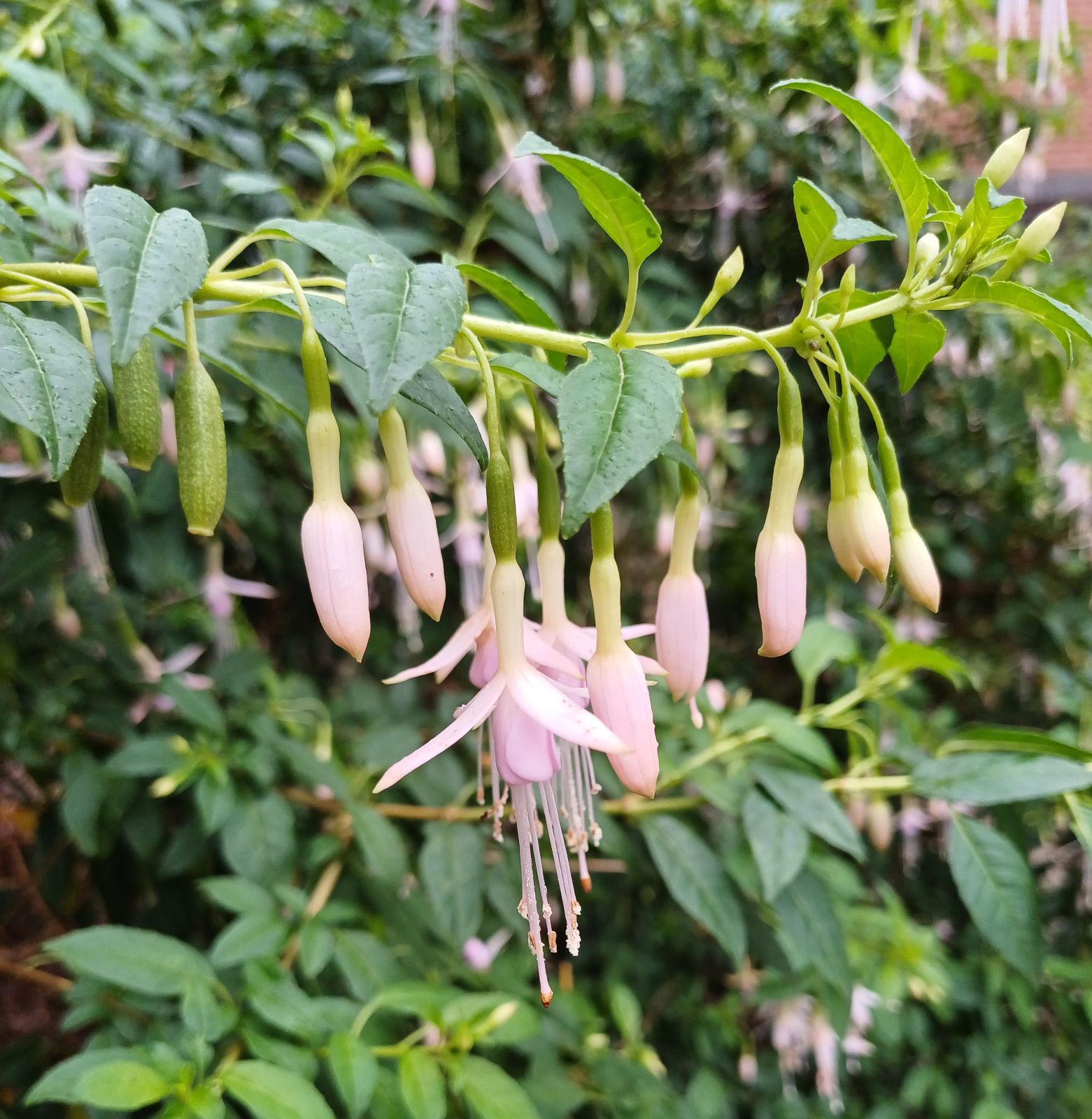Fuchsia magellanica
Credits
Article from Bean's Trees and Shrubs Hardy in the British Isles
Recommended citation
'Fuchsia magellanica' from the website Trees and Shrubs Online (treesandshrubsonline.
Genus
A shrub usually under 8 ft high but sometimes almost twice as high in shady, sheltered positions; young stems reddish, glabrous or slightly downy; older branches brown, with a peeling bark. Leaves opposite or in threes (often in fours on strong shoots), narrowly ovate to elliptic-ovate, up to 2 in. long, acute or acuminate at the apex, usually wedge-shaped at the base, irregularly edged with small, sharp, forward-pointing teeth, medium to dark green above, paler beneath, glabrous, or slightly downy on the veins beneath; leaf-stalks reddish, slender, 1⁄4 to 3⁄8 in. long, glabrous or downy. Flowers borne singly or two together in the leaf-axils on slender slightly downy stalks up to 2 in. long. Tube bright red, 3⁄8 to 1⁄2 in. long, more or less cylindric, but narrowed abruptly at the base where it joins the ovary and often gradually narrowing upwards towards the base of the sepals; sepals coloured like the tube, narrow-lanceolate, acuminately tapered at the apex, 3⁄4 to 1 in. long. Petals about half as long as the sepals, purple or blue-violet, obovate, convolute. Stamens exserted beyond the mouth of the corolla and, with the still longer style, forming a conspicuous feature of the flower. Fruits oblong, up to 7⁄8 in. long.
Native of Chile and bordering parts of Argentina from the latitude of Valparaiso southward to Tierra del Fuego; described by Lamarck from a specimen collected in December 1767, by the French naturalist Commerson in the region of the Straits of Magellan, but known earlier from Feuillée’s ‘Itinerary’, in which it is figured as ‘thilco’, a rendering of its native name. The date of introduction is often given as 1788 but it is probable that the fuchsias introduced around that date were really the Brazilian F. coccinea (q.v.). There is no sound evidence of the introduction of F. magellanica to Britain before the early 1820s.
F. magellanica is a moisture-loving plant which in the wild forms thickets along streamsides or in marshy places. Often its companion is Berberis darwinii, though that species is less demanding of moisture and occurs also in other associations. Its north-south range in Chile is about 1,500 miles and it is found from the coast to moderate elevations in the Andes. It varies not only in size of leaf and length of flower-stalk but also in such characters as leaf-shape, habit, length of internodes, degree of downiness, and, perhaps most significantly, in the shape and relative size of the parts of the flower. Apart from the white-flowered var. molinae (see below) Munz (op. cit.) recognises only two varieties:
From the Supplement (Vol. V)
† cv. ‘Sharpitor’. – Leaves grey-green, cream-edged. This arose as a sport in the National Trust garden at Sharpitor, Devon, and has been propagated.
Fuchsia Hybrids (page 243)
Some other cultivars suitable for planting in the open garden are:
‘Brilliant’. – A fairly hardy sort of upright habit. Sepals scarlet, corolla violet-purple; tube about 2 in. long.
‘Brutus’. – Of bushy habit, the short tube and sepals cherry pink and the corolla deep purple. Free-flowering.
‘Enfant Prodigue’. – A vigorous, bushy sort. Sepals crimson, reflexed. Corolla double, purple.
‘Graf Witte’. – The tube and forward-pointing sepals carmine, corolla purple. Vigorous and bushy.
‘Lady Thumb’. – Similar to ‘Tom Thumb’ in habit and really an improvement on it, the corolla being white, veined with pink.
‘Prosperity’. – Sepals deep rosy pink, forward-pointing. Corolla double, rosy pink. One of the best double sorts for the open garden, of vigorous, upright habit and free-flowering.
‘Rufus’. – Tube, the recurved sepals and corolla all red; anthers white. Bushy, upright habit, free-flowering and very striking.
‘Sealand Prince’. – Tube and sepals light red, corolla pale violet-purple. Upright and bushy, free-flowering.
'Thompsonii'
An old garden variety, raised before 1838 and almost certainly derived from the var. gracilis. It is bushier and leafier than the common form of that variety; the leaves are shorter and relatively narrower; the flowers are smaller but borne in great profusion from July to autumn. It is still one of the best of the hardy fuchsias, but does not assort well with the larger-flowered kinds.var. chonotica (F. Phil.) Reiche
Synonyms
F. chonotica F. Phil
var. conica (Lindl.) Bailey
Synonyms
F. conica Lindl.
F. macrostema var. conica (Lindl.) G. Don
var. discolor (Lindl.) Bailey
Synonyms
F. discolor Lindl
var. gracilis (Lindl.) Bailey
Synonyms
F. gracilis Lindl.
F. macrostema var.gracilis , (Lindl.) D. Don
F. decussata Graham, not Ruiz & Pavon
var. macrostema (Ruiz & Pavon) Munz
Synonyms
F. macrostema Ruiz & Pavon
var. magellanica
Synonyms
F. magellanica var. typica Munz
var. molinae Espinoza
Leaves pale green. Flower-stalks and ovaries green. Sepals almost white. Corolla pale lilac rose. This albino variant was first validly named and described in 1929, the type being a plant found on the island of Chiloe. But the same or a similar form had been introduced to cultivation in Britain by Clarence Elliott in 1926 and is still generally known as F. magellanica alba. In this the sepals spread horizontally; the style is pure white and a beautiful feature of the flower. It is interesting to note how this mutation has deprived all parts of the plant of the red or purple pigmentation that characterises the species; even the bark is paler. Unfortunately the cultivated plant is shy-flowering but worth growing, especially in milder parts, where it makes an elegant shrub with a fawn-coloured peeling bark. There is a fine example at Tresco Abbey in the Isles of Scilly and another in the Walled Garden at Nymans in Sussex. A.M. 1932.cv. ‘Pumila’. See F. ‘Pumila’ under hybrids, p. 246.cv. ‘Riccartonii’. See F. ‘Riccartonii’ under hybrids, p. 246.


